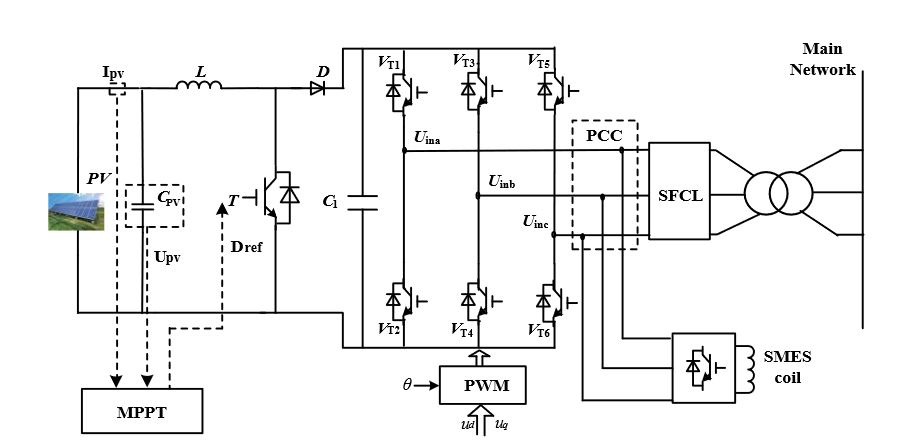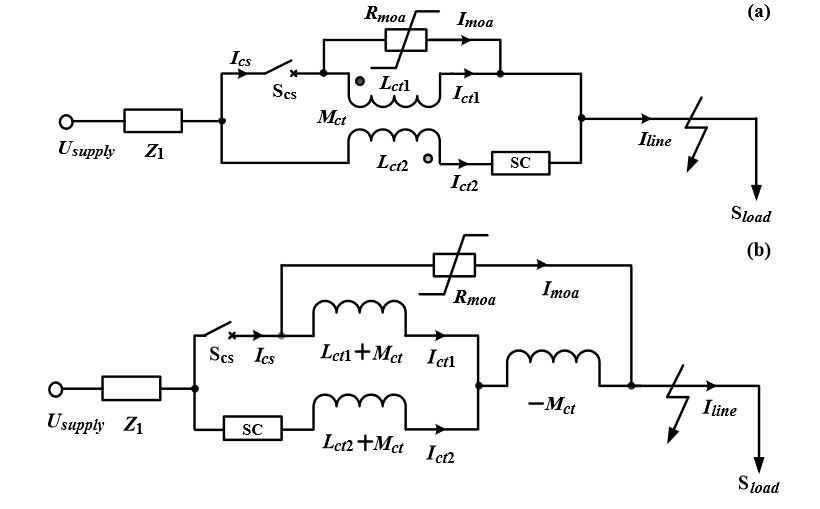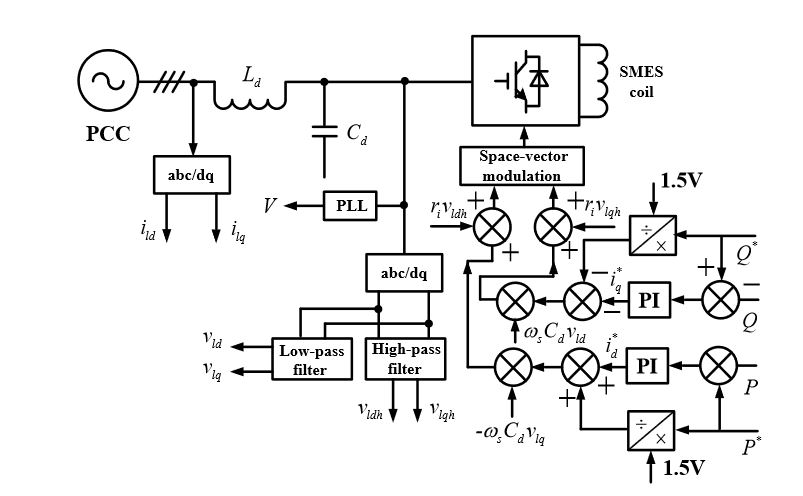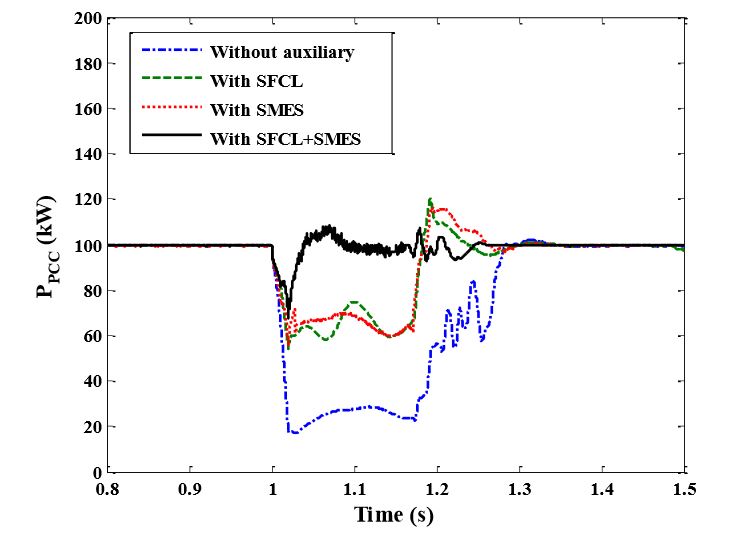ABSTRACT
In regard to the rapid development of renewable energy sources, more and more photovoltaic (PV) generation systems have been connected to main power networks, and it is critical to enhance their transient performance under short-circuit faults conditions. This paper proposes and studies the coordinated control of a flux-coupling-type superconducting fault current limiter (SFCL) and a superconducting magnetic energy storage (SMES), to improve the fault ride through (FRT) capability and smooth the power fluctuation of a grid-connected PV generation system.
Theoretical analyses of the device structure, operating principle and control strategy are conducted, and a detailed simulation model of 100 kW class PV generation system is built in MATLAB/SIMULINK. During the simulations of the symmetrical and asymmetrical faults, the maximum power point tracking (MPPT) control is disabled, and four different cases including without auxiliary, with SFCL, with SMES, and with SFCL-SMES, are compared.
From the demonstrated results, the combination of without MPPT and with SFCL-SMES can more efficiently improve the point of common coupling (PCC) voltage sag, inhibit the DC-link overvoltage and alleviate the power fluctuation. Finally, a preliminary parameter optimization method is suggested for the SFCL and the SMES, and it is helpful to promote their future application in the real PV projects.
THEORETICAL PRESENTATION OF A GRID-CONNECTED PHOTO VOLTAIC GENERATION SYSTEM

Figure 1. Configuration of a grid-connected photovoltaic (PV) generation system with superconducting
Figure 1 indicates the schematic configuration of a grid-connected PV generation system, which will be coupled to the main power network through a step-up transformer. The SFCL and the SMES unit are supposed to be installed at the point of common coupling (PCC) between the PV system and the set-up transformer for the main network.
CONFIGURATION OF THE SUPERCONDUCTING FAULT CURRENT LIMITER AND ITS EFFECTS ON THE PHOTO VOLTAIC GENERATION SYSTEM

Figure 3. Schematic structure of the suggested flux-coupling-type SFCL
Figure 3a shows the schematic configuration of the flux-coupling-type SFCL. This SFCL is mainly composed of a coupling transformer (CT), a controlled switch (CS) Scs, a superconducting coil (SC) and a metal oxide arrester (MOA). According to the CT’s equivalent circuit, Figure 3b shows the SFCL’s electrical equivalent structure. From this figure, the series and parallel connections among the coupling among the coupling windings, SC, MOA and Scs become more intuitive.
STRUCTURE, CONTROL AND CAPACITY DESIGN OF THE SUPERCONDUCTING MAGNETIC ENERGY STORAGE FOR THE PHOTO VOLTAIC GENERATION

Figure 5. Control block diagram of the SMES unit for achieving energy compensation. PI: proportional integral
In respect to the control block diagram of the SMES unit, it is indicated in Figure 5. The power regulator section calculates the required active power and reactive power, which should be supported by the SMES unit. Then, it generates the referenced d-axis and q-axis currents for carrying out the energy compensation.
SIMULATION STUDIES AND VERIFICATION

Figure 8. Three-phase voltages of the PV generation system under the symmetrical fault
Figure 8 shows the three-phase voltage characterstics of PV system under symmetrical fault network conditions. During the fault feeding process, the PV generation system’s output voltage coupled to the AC side will decrease from 200 V to 36 V (peak value), and the rate of decline in the voltage can reach to 82%. Concerning this fault case, the PV system cannot meet the FRT code, and it will be enforcedly seperated from main network.

Figure 10. Characteristics of the PCC power under the symmetrical fault
In the case of without auxiliary, the exchange power will decrease from 100 kW to 25 kW, and the 75 % average drop in the exchange power can be obtained. From this figure, the power compensation effect of only using the SFCL is similar to that of only using the SMES, and the PCC power can be approximatively improved to the level of 70 kW. Obviously, the coordination control of the SFCL-SMES can cause the best compensation effect.
OPTIMIZATION METHOD FOR THE SUPERCONDUCTING FAULT CURRENT LIMITER–SUPERCONDUCTING MAGNETIC ENERGY STORAGE
From the aforementioned simulation results, the coordinated control of the SFCL-SMES is able to play an efficient role in improving the PV generation system’s transient performance under the fault conditions. In principle, the introduction of these two superconducting devices will increase the investment costs, and meanwhile it should be noted that, the enhancement of the PV system’s transient performance can as well cause some considerable benefits, such as the reduction of the DC-link over voltage for protecting the capacitor, improvement of the PCC power for ensuring the utilization efficiency of renewable energy, stabilization of the supply load for avoiding the energy outage.
CONCLUSIONS
This paper proposes and studies the coordinated control of a flux-coupling-type SFCL and a SMES unit, so as to improve the transient performance of a grid-connected PV generation system under the symmetrical and asymmetrical faults. Both of theoretical derivation and simulation analysis are carried out. On the basis of that MPPT control is disabled during the faults, four different cases including without auxiliary, only with SFCL, only with SMES, and with SFCL-SMES are compared in detail. Moreover, a preliminary parameter optimization method is suggested for the SFCL-SMES. According to the demonstrated results, the authors draw the following conclusions:
(1) The single use of the SFCL has a better effect on limiting the fault current, but weaker effects on the power compensation and DC over voltage inhibition. The single use of the SMES can provide flexible power compensation, but it has a larger capacity requirement and a weaker effect on improving the voltage sag. In contrast, the coordinated control of the SFCL and the SMES can offer the best comprehensive performance. The combination of without MPPT and with SFCL-SMES can more efficiently improve the PCC voltage sag, inhibit the DC-link over voltage and alleviate the PV system’s power fluctuation. Thus, the PV system’s robustness against short-circuit faults can be well strengthened.
Source: Wuhan University
Authors: Lei Chen | Hongkun Chen | Jun Yang | Yanjuan Yu | Kaiwei Zhen | Yang Liu | Li Ren
>> 200+ Matlab Projects based on Control System for Engineering Students